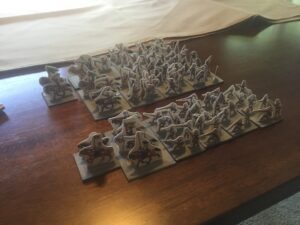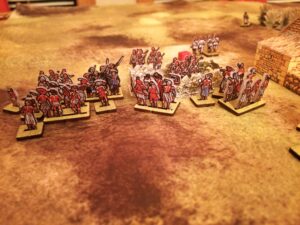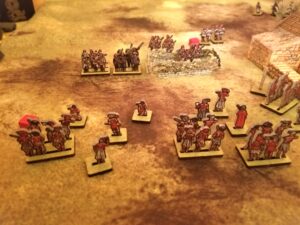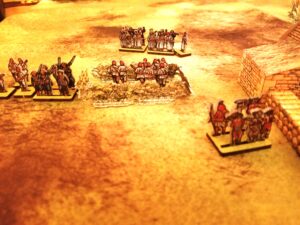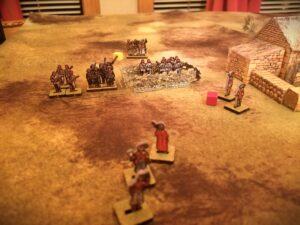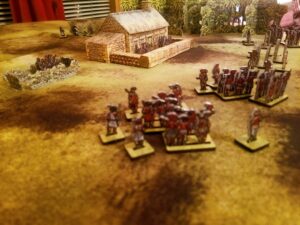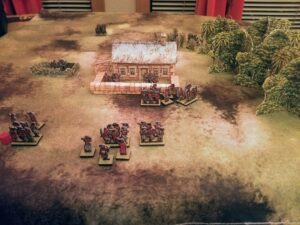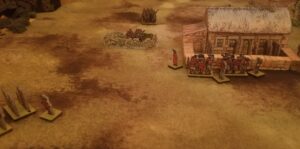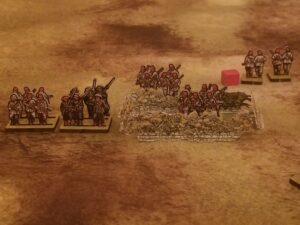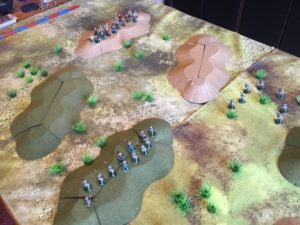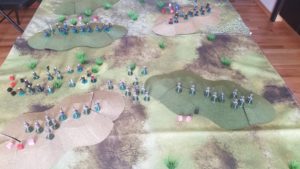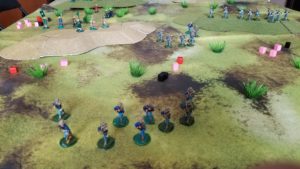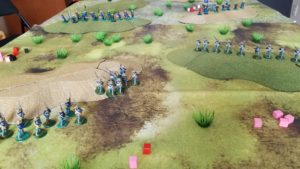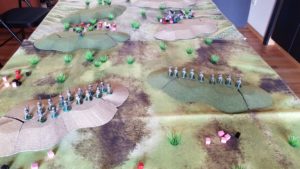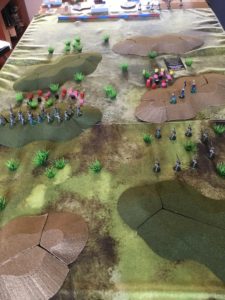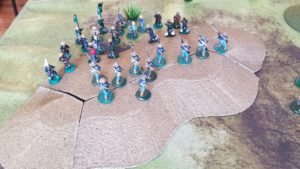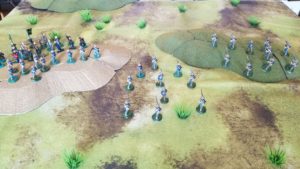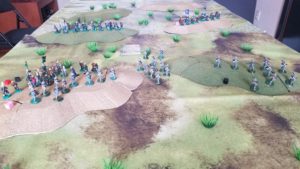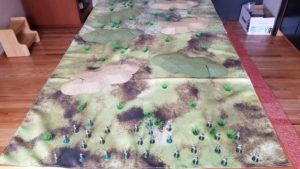While pawing through a closet I found a WalMart plastic bag. “What The Hell Is This?”. Well, this is this…….
Category Archives: Colonials
The Men Who Would Be Kings – Some Observations
I refrained from any review-type comments about this rule set in my initial post.
Changed my mind.
This is a good set of rules. Easy to digest and fun to play. The general structure is very similar to “Pikeman’s Lament”, but provides excellent historical context.
The temptation here is to start layering on house rules to increase rule “realism”. Then it becomes something it is not. I’m sure the author considered anything I thought about and, after careful consideration, declined to add another layer of complexity and/or chrome.
This result is a rule set placing an interesting burden on the players – a different sand box so to speak – to construct interesting scenarios with interesting smaller forces with interesting mixes of troop-types.
What a relief! No longer are colonial battles limited to big games with small, highly disciplined, regular units decimating wave-after-wave of native hordes. Rorke’s Drift is so boring.
Here are some thoughts based on my initial play-throughs and formulaic scenario described in my previous posts.
- Make the majority, if not all, of your Askari units Irregulars. As Irregulars, their musketry and hand-to-hand capabilities will make them far more vulnerable.
- Upgrade at least one (1) Tribal unit to “well armed”. Longer range will increase their ability to inflict casualties and pin opposing forces. A pinned unit is very vulnerable in melee.
- Use “Go To Ground” for native units in the open and waiting to assault.
- “On The Double” is one way to allow your Tribal units to remain out of deadly short-range weapons fire (especially when delivered by Regulars), and have decent chance of attacking into melee. All you have to do is roll a D6x5 or D6x6 to get the extra move distance. Try it with multiple units.
- Vary the leader rating of your Native units to avoid a cycle of pin/rally/pin.
More Action! (Finally)
Been fishing. Time to finish up the narrative on my latest game.
The Natives finally launched a coordinated attack against both the Zariba and troops in the open.
The attacks were repulsed by a combination of good (Colonials) and bad (Tribal) die rolls. The Africans will be flayed by rifle fire while attempting to rally. Notice the Arab Band unable to get it together in the upper right corner of the photo.
The Arab contingent finally swung into action, making quick work of the small Askari unit detached from the main body of the relief force. However, their attempt to assault the Zariba from the rear was shattered by accurate Askari rifle fire.
The Regulars and Askaris now decimated the pinned Native and Arab units, which were unable to rally and charge back into close contact. Very few remained on the field at the end of the engagement.
An entertaining game. I’ll follow-up with some thoughts on the rules in my next post.
Action! (Finally)
Enough of the musings for now.
Been playing an African scenario using “The Men Who Would Be Kings” rules by Osprey.
Threw out a terrain cloth on a living room table, set up some paper scenery, and organized my WoFun troops.
One of the criticisms leveled at these rules is that Tribal units are battered by modern weapons fire and are quickly pinned and attritted without getting close enough to to melee with the Colonial regulars or irregulars.
So, I set up a small “Last Stand” scenario to judge for myself. All Tribal units had a morale rating of seven (7), with the Colonial at six (6). Morale checks involve a D6x2 role equal to or greater than the morale rating.
My first try involved a force ratio of 1:1 and, sure enough, the tribal units were paralyzed and shredded. I increased the number of tribal units for my second try.
The colonial troops are deployed by sections of six (6) figures, with a unit comprising two sections or twelve (12) figures as per Rules As Written (RAW). The colonial force is comprised on Askaris (classed as Irregulars) with a section of Naval Infantry (classed as Regulars – better morale and melee capability). Tribal units/bands are sixteen figures (16) each, as per RAW.
The initial set-up looking northeast. Askaris occupy the fortified house and a zariba. Reinforcements are somewhere in the offing. I’ll trigger their movement with a “Yes/No” die roll when the Tribal units get within a charge move of the house. Right now – given table space – the Tribal units are at long range, one move from where they are on the table.
Tribal advance hampered by failed activation checks. But, one unit charges an Askari section engaging in melee. Overwhelmed, the Askaris are destroyed, without inflicting a casualty. The Tribal band occupies one half of the Askari fortified position. The other Tribal units advance, taking casualties. One pinned band is destroyed by fire from the zariba position.
Another Tribal band assaults the house, engaging the other Askari section. The reinforcements, after some hesitation, advance in column at the quick. The Tribal band concealed in the elephant grass fails their activation check, losing their chance at an ambush, and remain in place.
Reinforcements arrive, advancing past the fleeing Askaris (red cube indicates pinned – and needing a morale check) to support the zariba position, choosing not to re-take the house. This may be a tactical error. One Askari section needs to take additional time to enter the zariba.
I’ll get back to the game this evening.
Paper, Plexiglass and PDFs: A low cost wargaming path of less resistance
Over the past couple of years I’ve become intrigued with paper soldiers, terrain and buildings as a low cost, lower time alternative that allows me to tryout intriguing new rule sets as well as an alternative to my ham-fisted DIY efforts.
I initially started out with paper buildings for my Fistful of Lead games.
My first paper soldiers were sourced through Wargame Vault using Batalov’s titles, as well as those created by “Antohammer”.
Earlier this year I discovered Peter’s Paperboys, featuring both Peter Dennis’ quality work and others.
Combining these low cost figures with (comparatively) low cost PDF rules opened up a number of possibilities, especially skirmish or small unit encounters, with quick set-up, small footprint and big fun.
Two new rule sets I’ve been working with that combine attributes of both skirmish and small unit (s) games are Osprey’s Pikeman’s Lament and The Men Who Would Be Kings. These sets have been exhaustively covered, so there’s no need to go into any discussion here.
The paper soldiers provide the ability not only to get into the rules, but create interesting matchups. For example: Portuguese vs. Spanish Conquistadors for “Lament” and Late 19th Century Russians vs. Central Asian Factions in “Kings”.
The overhead for each of these games was no more than $20 each, all-in with rules, figures, terrain and professional printing.
A bonus is that cutting out 28mm figures and terrain, as well as 15-18mm buildings gives me an excuse to have football on and not feel like I’m wasting time.
It was then just a short jump to WoFun’s 18mm plexiglass figures. This range also includes 28mm figures, with work by both Batalov, Dennis and others. Why 18mm? Because 18mm paper soldiers are just too hard to cut out.
Yes, the plexiglass figures are more expensive and postage from the UK is a drag (although some sets are available from US based Raven Banner Games).
I purchased British and a variety of African Askaris, Arabs and Tribal figures for skirmishes and a campaign using the “Men” rules.
I’m really enjoying this combination of interesting match-ups and quick set-ups.
TSATF – Last Move
Rolled for Boxer resistance on the last two ridges. None on one ridge, and one, passive, unit -with only four riflemen, on the other.
Don’t need to play this out. Marines will simply engage at a distance, and force them off.
This game turned out well. I’m fairly satisfied with my solo adjustments for Boxer placement, strength and aggressiveness.
I did roll for Marine casualties. Four of the eleven lightly wounded are now considered seriously wounded. Add those to the four KIA and other three seriously wounded, and the Marines took roughly 1/3 casualties. High price.
Well, time to put them back in their cabinet and start playing Husaria.
TSATF Skirmish Continues
Well, maybe not that interesting at first, but later the situation became too interesting for the Marines.
The Boxers failed the morale check needed to charge the Marines occupying the west ridge line; ran off the ridge and went prone/pinned. Elsewhere the firefight continued, with both sides sustaining casualties. Surprisingly, the retreating Boxer unit rallied on a die roll of “1”.
Here’s photo of the situation.
The riflemen of the rallied Boxers turned to engage the Marines moving through the saddle, while the remainder charged and closed with the Marines to their front. The Marines moving through the saddle, in turn, charged the detached riflemen.
Both Marine units were pushed back! In TSATF, hand-to-hand combat is simply a comparison of die rolls, and the Boxers were rolling well. Despite losses, the Boxers held the west hill.
However, the Boxers unit losses were now greater than fifty percent. The detachment on the hill failed the required morale check and fled (final turn phase after shooting). The riflemen, however, passed their check and remained in place.
In the following turn, the two Marine squads rallied and moved back towards the west ridge, staying in defilade. The Boxer riflemen focused on the remaining Marine unit, but their fire was ineffective. Here’s a photo of the situation at the end of this turn.
Quick Note: I’m keeping the casualty cubes in-place for an end-of-game count. Red indicates a serious wound, pink a light wound, and black for death
The Marines regained the crest of the west ridge and engaged the Boxers to their front. The Boxers literally fought to the last man. The Boxers holding the east ridge drew an event card reducing their effective firing range to only 12 inches, or not far enough to engage the Marines to their front. They wisely withdrew to the reverse slope.
The Marines advanced through the open ground to take the east ridge. Here, the Boxers emerged from defilade, but retreated after taking casualties and failing their morale check.
While this action was taking place, Marines occupied the west ridge. Here’s a photo of the current situation.
Lots of wristage before next turn’s action. Have to determine who and what will be on the final two ridges. I will also inventory all losses, clean up the casualty cubes, and maybe die to see which of the lightly wounded Marines can no longer continue.
Skirmish Adjustments
Making adjustments in my search for appropriate solo randomness for The Sword And The Flame (TSATF).
The most pressing problem was the reaction of Chinese forces placed on reverse slopes. After playing through a couple of turns decided to go with dicing for passive, aggressive and fanatic designations for all Chinese units when placed on the table.
Passive will hold in place until enemy is no more than six (6) inches away. Aggressive units will move as the situation dictates, and Fanatics will move to contact towards the nearest enemy unit regardless of situation, distance, etc. A percentage die roll of 10 or less (0 =0) results in a passive designation, with 20-70 creating an aggressive unit, and fanatics at a higher roll.
Given the high number of Boxer riflemen (probably higher than historical), any lightly wounded Marine casualties are recorded, but the figure stays in the fight.
The Marines encountered resistance while approaching the ridge to the west. The ridge to the east was unoccupied.
The passive Boxers emerged from the reverse slope, and engaged the Marines with firearms. Their next move will be into melee.
The other two Marine squads continued to advance, occupying the east hill and advancing through the saddle between ridgelines.
Force composition die rolls were made as both units were within twelve (12) inches of the next two ridges. The results were not pretty, with two aggressive units, each equipped with a high number of firearms, are now situated on each ridge crest.
Tomorrow’s turns should prove interesting.
Skirmish Mission
Rhonda’s enjoying Palm Springs weather, so I’ve set up The Sword And The Flame (TSATF) on the dining room table.
The scenario calls for the Marines to clear a series of ridges.
I’m considering all ground to be rough ground for shooting, so there is a -1 DRM for all firing. However, the ground will be considered clear for movement, so without penalty.
Visibility is twelve (12) inches from ground to crest, unlimited from crest to crest, and crest to base of next hill.
The challenge is coming up with some solo-friendly randomness. Here’s a quick and sketchy overview.
My initial stab at this problem is to use the Action, Event and Terrain cards published by The Virtual Armchair General.
An Event will be triggered by a die roll of six (6), and confirmed by a Yes/Maybe die roll.
Whether or not a terrain feature is occupied will be determined by a 10 sided die. A roll of four (4) or less means the feature is unoccupied. A roll of five (5) to eight (8) means a Boxer force is occupying the crest. A roll higher means the Boxers are on the reverse slope.
Another percentage die roll determines force composition. A roll of four (4) or less means Regulars. Another outcome results in a Boxer force. For the Boxers, another roll gives the number of figures with firearms. All Regulars carry rifles.
Terrain cards will be drawn when Marines enter a “new” terrain feature – either a slope or the “new” ground beyond a ridge line. These cards will indicate if movement is slowed.
Any casualties are considered to be out of this game. Wounded figures will be diced for at the end of the game, anticipating a follow up contest.
And Another…..Another
OK, this is small and pathetic….but it’s the last piece for my 15mm British colonial forces.
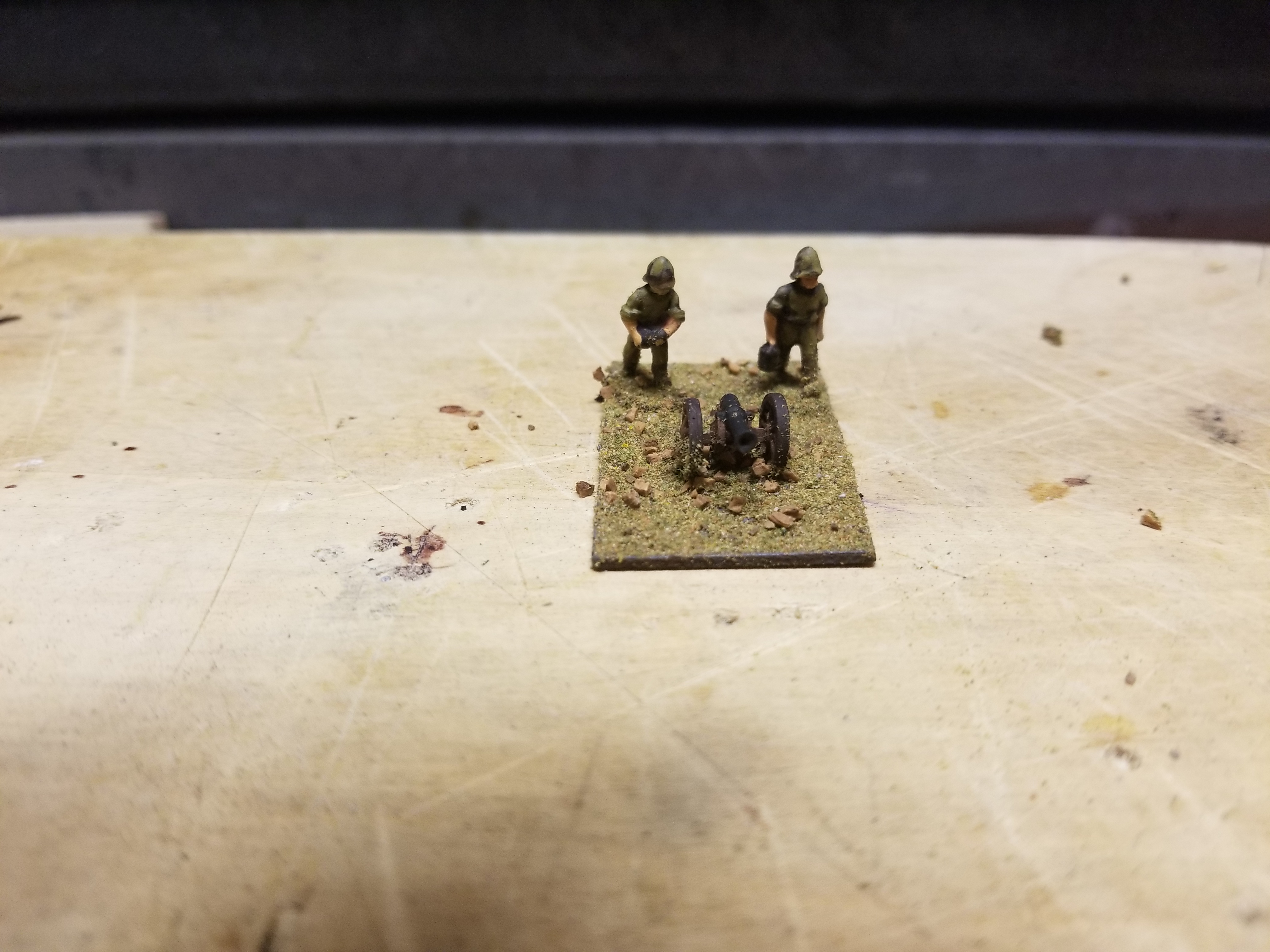
This particular group goes back to my Kansas City days, and the great, unrealized, World At War 1898 project. I sold off my French figures, but kept one large unit of Highlanders. Sometime last year, I re-discovered a cache of unpainted Sikh, British and miscellaneous Minifigs, and decided to paint them up. The plan is to use them in a campaign against my Arab hordes (what a versatile force….good for late Ancients through the 19th Century). The idea of a campaign also provided the motivation to order and paint baggage camels, and other domesticated animals for proper camps and baggage trains.
After some research using the usual resources, I decided to use a couple of rule. The first is Soldiers of the Queen.
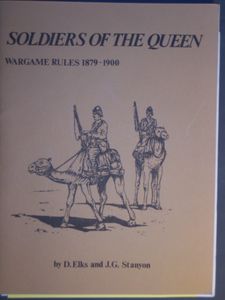
I have a weakness for Tabletop Games figures and rules. Don’t know why. This a fairly straight-ahead 19th century colonial proposition, but livened up with event cards, and a number of army lists for various sized forces. This flexibility in army size is a very good thing for a campaign game.
The other is Science vs. Pluck.
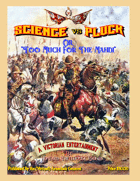
This not just a set of rules, but also compendium of ideas, a character creation resource and source of general information. It is designed for the Sudan, and to be played with an umpire. I think it’s more versatile than that. Long out of print, it is available for download at The Wargamevault.
Don’t know when I’ll get the figures out on the table, but it is nice to have the painting finished.
